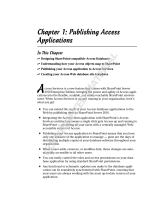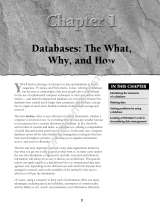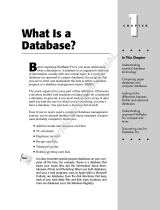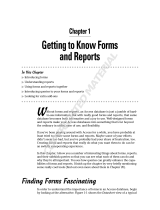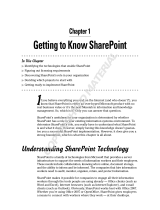Page is loading ...

Chapter 1
Getting to Know Access 2007
In This Chapter
Deciding when to use Access
Unlocking the basics of working with Access
Figuring out how to get started
A
ccess 2007, the most recent version of Microsoft Office’s database appli-
cation, is a very robust and powerful program. You probably already
know that, and perhaps that power, or your perceptions of all that Access can
do, is what made you reach for this book. Good decision!
For all of Access’s power, it’s important to note that Access is also very —
pardon the expression —
accessible. It’s pretty easy to use at the edges,
where a new user will be; you don’t have to venture all the way in to its core
to get quite a lot out of the software. In fact, with just the basic functionality
that you’ll discover in this book, you’ll be able to put Access through many
of its most important paces, yet you’ll be working with wizards and other
on-screen tools that keep you at a comfortable arm’s distance from the soft-
ware’s inner workings, the things that programmers and serious developers
play with.
You don’t need to use every feature and tool and push the edges of the
Access envelope. In fact, you can use very little of everything Access has to
offer and still have quite a significant solution to your needs for storing and
accessing data — all because Access can really “do it all” — enabling you to
set up a database quickly, build records into that database, and then use that
data in several useful ways. Later on, who knows? You may become an
Access guru.
In this chapter, you’ll discover what Access does best (and when you might
want to use another tool instead), you’ll see how it does what it does, and
hopefully you’ll begin to understand and absorb some basic terminology.
Now, don’t panic — nobody’s expecting you to memorize any vocabulary or
anything scary like that. The goal here (and in the next two chapters) with
regard to terms is to introduce you to some basic words and concepts that
will help you make better use of Access in general and in the subsequent
chapters in this book, too.
05_046120 ch01.qxp 11/15/06 1:57 PM Page 9
COPYRIGHTED MATERIAL

What Is Access Good For, Anyway?
What is Access good for? That’s a good question. Well, the list of what you
can do with it is a lot longer than the list of what you
can’t do with it — of
course, only if you leave things like “paint your car” and “do the dishes” off
the “can’t do” list. When it comes to data organization, storage, and retrieval,
Access is at the head of the class.
Building big databases
What do I mean by big database? I mean any database with a lot of records.
And by
a lot, I mean hundreds. And certainly if you have thousands of
records, you need a tool like Access to manage them. Although you can use
Microsoft Excel to store lists of records, you are limited as to how many you
can store (the number of rows in a single worksheet) and you can’t set up
anything beyond a simple list that can be sorted and filtered. So anything
with a lot of records is best done in Access.
Some reasons why Access handles big databases well:
Typically, a big database has big data entry needs to go along with it.
Access offers forms, or more accurately, the ability for you to create a
quick form through which someone can enter all those records. This can
make data entry easier and faster and can reduce the margin for error
significantly. Check out Chapter 5 for more information on building
forms.
When you have lots and lots of records, the margin for error within
them — duplicate records, records with misspellings, records with miss-
ing information — is great. So you need an application like Access to
ferret out those errors and fix them. See Chapter 9 to see how Access
lets you find and replace errors and search for duplicate entries.
Big databases mean big needs for accurate, insightful reporting. Access
has powerful reporting tools that allow you to create printed and on-
screen reports that include as few or as many pieces of your data as you
need, and to include data from more than one table in the report. You
can tailor your reports to your audience, from what’s shown on the
reports pages to the colors and fonts used.
Big databases are hard to wade through when you want to find some-
thing. Access provides several tools for sorting, searching, and creating
your own specialized tools (known as
queries) for finding the elusive
single record or group of records you need.
10
Part I: Basic Training
05_046120 ch01.qxp 11/15/06 1:57 PM Page 10

Access saves time by giving you great tools for importing data from
other sources, such as Excel worksheets (if you started in Excel and
have maxed out its usefulness as a data storage device) and Word
tables. This saves you from re-entering all your data and allows you to
keep multiple data sources consistent.
Creating databases with multiple tables
Whether your database holds 100 records or 1,000 records (or more), if you
need to keep separate tables and relate them for maximum use of the infor-
mation, you need a
relational database — and that’s Access. How do you
know whether your data needs to be in separate tables? Think about your
data — is it very compartmentalized? Does it go off on tangents? Consider
the following example and apply the concepts to your data and see if you
need multiple tables for your database.
The Big Customer database
A large contracting business has a database of customers — past, present,
and potential clients — and wants to keep track of a lot of information on
them. For the current and past clients, the bigwigs want to store information
about the work that was done, what materials were used — paint colors, tile
designs, carpet styles, preferred fixtures, and so on. For potential customers,
they want to keep track of when and how they’ve contacted them with mail-
ings, phone calls, and visits from sales reps. Imagine keeping all of that in a
single table — with everything from the customer’s name to what wallpaper
was used in the bedroom.
For a complex database like this one, you’d need multiple tables, as follows:
One table would house the customer contact information — names,
addresses, phone numbers, fax numbers, and e-mail addresses. A field
one might also include would be customer number, which makes each
record unique, and in that number, one or more of the characters could
be used to differentiate between different customer types — past, cur-
rent, or potential.
A second table would contain the customer number again (as a way
to link or connect the two tables) and also the customer’s status
information — what work was done (kitchen, bathroom, painting,
restoration, any number of established classifications) and what was
charged for the work.
A third table, again containing the customer number, would include the
customer’s preferences for paint manufacturers and colors, wallpaper,
tile, countertops, fixtures, carpet, and so on. Because you don’t have to
fill in every field in a record, if no carpeting was done for a particular
customer, for example, that field can be left blank.
11
Chapter 1: Getting to Know Access 2007
05_046120 ch01.qxp 11/15/06 1:57 PM Page 11

With these three tables in place, any type of customer (past, current, or
potential) can be entered into the database, and only the table or tables that
apply to that customer need be populated with data. When a potential cus-
tomer becomes a current one, relevant data can be entered into the appropri-
ate table(s). If a potential customer never buys, he or she can be deleted
when a prescribed length of time has elapsed, or perhaps a fourth table, with
archived customer records, can be set up. The options are limited only by
your needs and intended use of the data.
Failure to plan? Plan to fail
If you think carefully about your database and how you use your data and
what you need to know about your customers, products, or whatever you’re
storing information about, you can plan
How many tables you’ll need
Which data will go into which table
How you’ll use the tables together to get the reports you need
Feel free to sketch your planned database on paper, drawing a kind of flow
chart with boxes for each table and lists of fields that you’ll have in each one.
Draw arrows to show how they might be related — sort of like drawing a
simple family tree — and you’re well on your way to a well-planned, useful
database.
Here’s a handy procedure to follow if you’re new to the process of planning a
database:
1. On paper or in a word processing document, whichever is more com-
fortable, type the following:
• A tentative name for your database
• A list of the pieces of information you get from that database on a
daily or regular basis
2. Now, based on that information, create a new list of the actual details
you could store:
List every piece of information you can possibly think of about the cus-
tomers, products, ideas, cases, books, works of art, students — whatever
your database pertains to. Don’t be afraid to go overboard — you can
always skip some of the items in the list if they don’t end up being things
you really need to know or can possibly find out about each item in your
database.
3. Take the list of fields — that’s what all those pieces of information
are — and start breaking them up into logical groups.
12
Part I: Basic Training
05_046120 ch01.qxp 11/15/06 1:57 PM Page 12

How? Think about the fields and how they work together:
• If the database keeps track of a library of books, for example, per-
haps the title, publication date, publisher, and ISBN (International
Standard Book Number, which is unique for each book), price, and
page count can be stored in one group, and author information,
reviews, and lists of other titles by the same author or books on the
same topic can be stored in another group. These groups become
individual tables, creating your relational database of books.
• Figure out what’s unique about each record. As stated in the previ-
ous point, you need a field that’s unique for each record, and while
Access can create this for you if no unique data exists for each
record in your database, it’s often best if you actually have or
create one yourself. Customer numbers, student numbers, book
ISBNs, catalog numbers, serial numbers — anything that won’t be
the same for any two records will do.
With a big list of fields and some tentative groupings of those fields at
the ready, and with an idea of which field is unique for each record, you
can begin figuring out how to
use the data.
4. Make a list of ways you might use the data:
• Reports you’d like to create, including a list of which fields should
be included for each report.
• Other ways you can use the data — labels for mailings, product
labels, catalogue data, price lists, contact lists, and so on.
5. List all the places your data currently resides — on slips of paper in
your pocket, on cards in a box, in another program (such as Excel), or
maybe through a company that sells data for marketing purposes.
With this planning done, you’re ready to start building your database. The
particulars of that process come later in this chapter and in subsequent
chapters, so don’t jump in yet. Do pat yourself on the back, though, because
if you read this procedure and applied even some of it to your potential data-
base, you’re way ahead of the game, and I feel very positive about your abil-
ity to make good use of all that Access has to offer.
Databases with user forms
When planning your database, consider how the data will be entered:
If you’ll be doing the data entry, perhaps you’re comfortable working in
a spreadsheet-like environment, known in Access as
Table view, where
the table is a big grid, and you fill it in row by row (each row is a record).
Figure 1-1 shows a table in progress in Table view. You decide — is it easy
to use, or can you picture yourself forgetting to move down a row and
entering the wrong stuff in the wrong columns as you enter each record?
13
Chapter 1: Getting to Know Access 2007
05_046120 ch01.qxp 11/15/06 1:57 PM Page 13

You may want to use a form (shown in Figure 1-2), a specialized interface
for data entry and editing and for viewing your database one record at a
time, if
• Someone else will be handling data entry
• Typing row after row of data into a big grid seems mind-numbing.
Figure 1-2:
A form for
entering
new
records or
reviewing
existing
ones can be
a great tool.
Figure 1-1:
Table view
can be
an easy
environment
for data
entry. Or
not.
14
Part I: Basic Training
05_046120 ch01.qxp 11/15/06 1:57 PM Page 14

You can find out all about forms in Chapter 5, and if your database is
large enough to require help doing the data entry, or if it will continue to
grow over time and an on-going data entry process is likely, Access is
the tool for you. The fact that it offers simple forms of data entry and
editing is reason enough.
Databases requiring special reporting
Yet another reason to use Access is its ability to create customized reports
quickly and easily. Some database programs, especially those designed for
single-table
flat file databases, have some canned reports built in, and that’s
all you can do — just select a report from the list and run the same report
every other user of that software runs.
If you’re an Excel user, your reporting capabilities are far from easy or simple,
and they’re not designed for use with large databases — they’re meant for
spreadsheets and small, flat-file lists. Further, you have to dig much deeper
into Excel’s tools to get at these reports. Because Access is a database appli-
cation, reporting is a major feature.
An example? In Excel, to get a report that groups your data by one or more of
the fields in your list, you have to sort the database first, using the field/s to
sort the data, and then you can create what’s known as a subtotal report. To
create it, you use a dialog box that asks you about calculations you want to
perform, where to place the results, and whether you’re sorting and subtotal-
ing on more than one field. The resulting report is not designed for printing,
and you have to tinker with your spreadsheet pagination (through a special-
ized view of the spreadsheet) in order to control how the report prints out.
In Access? Just fire up the Report Wizard, and you can sort your data, choose
how to group it, decide which pieces of data to include in the report, and pick
a visual layout and color scheme — all in one simple, stream-lined process.
Without your doing anything, the report is ready for printing. Access is built
for reporting, because it’s a database application — and reports are one of
the most, if not
the most important way you’ll use and share your data.
Because reports are such an important part of Access, you can create them
quickly and easily, but you can also customize them to create powerful docu-
mentation of your most important data:
Build a quick, simple report that just spits out whatever’s in your table
in a tidy, easy-to-read format. See Figure 1-3 for a sample.
Create a customized report that you design step-by-step with the Report
Wizard. See Figure 1-4.
You can really roll up your sleeves and design a new report or play with
an existing one, adding all sorts of bells and whistles. Figure 1-5 shows
this happening in Design view.
15
Chapter 1: Getting to Know Access 2007
05_046120 ch01.qxp 11/15/06 1:57 PM Page 15

Figure 1-4:
The Report
Wizard
creates
more
elaborate
(yet simple)
reports, like
this one.
Figure 1-3:
Ah,
simplicity. A
quick report
is just one
click away.
16
Part I: Basic Training
05_046120 ch01.qxp 11/15/06 1:57 PM Page 16

So, you can create any kind of custom report in Access, using any or all of
your database tables and any of the fields from those tables, and you can
group fields and place them in any order you want:
With the Report Wizard, you can choose from several preset layouts for
your report, and it can all be customized row by row, column by column.
Quick Format buttons apply preset designs to existing reports.
If you want to place your personal stamp on every aspect of your report,
you can use Design view to
• Add titles, instructional or descriptive text boxes, and graphics.
• Set up customized headers and footers to include any information
you want to appear on all the report’s pages.
If all this sounds exciting, or at least interesting, then you’re really on the
right track with Access. The need to create custom reports is a major reason
to use Access, and you can find out about all these reporting options in
Chapters 14 through 17. That’s right: four whole chapters on reporting — it
must be a big feature in Access!
Figure 1-5:
You
can
avoid
Design
view, but to
really
customize
things, you’ll
need it.
17
Chapter 1: Getting to Know Access 2007
05_046120 ch01.qxp 11/15/06 1:57 PM Page 17

How Access Works and
How You Work with It
When you look at all the applications in Microsoft Office — Word, Excel,
PowerPoint, Outlook, and of course, Access — you’ll see some features that
are consistent throughout the suite. There are big differences, too, and that’s
where books like these come in handy, helping you deal with what’s different
or not terribly obvious to a new user.
Access has several features in common with the rest of the applications in
the Microsoft Office suite. You’ll find the same buttons on several of the tabs,
and the Quick Access toolbar, demonstrated in Chapter 2, appears in all the
applications, as do the items on the menu.
If you already know how to open, save, and print in, say, Word, you’re proba-
bly ready to do the same things in Access without any difficulty.
To make sure you’re totally Access-ready, here are the basic procedures to
make sure that you have a solid foundation on which to build.
Opening Access
Access opens in any one of several ways. So, like a restaurant with a very
comprehensive menu, some people will love all the choices, and others will
say, “I can’t decide! There are just too many things to choose from!” Of
course, the multiple ways to open Access aren’t designed to suit any diner’s
palate, but to accommodate all the different situations Access users find
themselves in.
Now, you’ll run into situations in which one of the ways is the glaringly best
choice — hands down, that one will be the way to go. But what if you’ve
never heard of it? You’ll be trying to find my phone number (I’m unlisted —
ha!) so you can give me a piece of your mind. So to acquaint you with
all your
choices, so you’ll be ready for any situation, here are all the ways that you
can open Access:
Click the Start menu button (in the lower-left corner of the screen) and
choose All Programs
➪Microsoft Office➪Microsoft Office Access 2007.
Figure 1-6 shows my Start menu. I have a lot of programs, many of which
you may not have; don’t worry about that — just focus on the Microsoft
Office submenu and make your choice from that.
If you’ve recently used Access, it’s listed on the left side of the Start
menu (see Figure 1-7). Just choose Start
➪Microsoft Office Access 2007,
and Access opens.
18
Part I: Basic Training
05_046120 ch01.qxp 11/15/06 1:57 PM Page 18

Figure 1-7:
Been there,
done that —
and the
Start menu
knows it.
Figure 1-6:
The
Windows
Start menu
offers all the
Microsoft
Office
applications
in one
submenu.
19
Chapter 1: Getting to Know Access 2007
05_046120 ch01.qxp 11/15/06 1:57 PM Page 19

Double-click any existing Access database file on your Desktop or in a
folder (as shown in Figure 1-8). Access opens automatically.
Access 2007 will open the database files you created with previous ver-
sions of Access, and should support whatever features are employed
within the database. All your tables should open properly, and reports,
forms, and queries should all work fine, too.
If some helpful person has added Access to the Quick Launch toolbar
(on the Windows Taskbar), you can click the Access 2007 icon (it looks
like a pink key) and there you go. Access opens for you right then and
there.
Does having an Access icon on the Taskbar sound extremely convenient? It is!
To add the icon, follow these steps:
1. Choose Start➪Microsoft Office.
2. Hold down the Ctrl key and click and drag the Access menu command
down to the Quick Launch bar.
A black I-beam will appear where you point with your mouse on the bar,
indicating where the new icon will go.
3. Release the mouse button and then the Ctrl key
You’ve got yourself single-click access to, well, Access.
Figure 1-8:
Double-click
an Access
database
file, and
Access
opens
right up.
20
Part I: Basic Training
05_046120 ch01.qxp 11/15/06 1:57 PM Page 20

Selecting a starting point
So Access is open, and assuming you opened it from the Start menu or from
the Quick Launch bar, you’re staring at the Access interface, which includes
some features whose purposes may elude you or that you may not know how
to use. Hey — don’t worry — that’s why you’re reading this book!
You can find out more about all the tabs and buttons, panels and menus, and
all that fun stuff in Chapter 2 — for now, just look at the ways Access lets you
get started with your database, be it an existing one that needs work or a new
one you have all planned out and ready to go.
Opening an existing database
Well, this is the easy one. If a database already exists, you can open it by
selecting it from the Open Recent Database list on the far right side of the
Access window (see Figure 1-9). Just click once on the database in the list
and it opens, listing its current tables, queries, reports, and forms on the far
left side of the window.
When the database is open, you can open its various parts just by double-
clicking them in that left-most panel, and whatever you open appears in the
main, central part of the window. Figure 1-10 shows a table, ready for editing.
Figure 1-9:
Pick your
recently
used
database
from the list
on the right
and see its
parts listed
on the left.
21
Chapter 1: Getting to Know Access 2007
05_046120 ch01.qxp 11/15/06 1:57 PM Page 21

After you open a table, you can begin entering or editing records — and you
can read more about how that’s done in Chapter 6, where the different ways
to edit your data and tweak your tables’ setups are demonstrated. If you want
to tinker with any existing queries, these, too, open just by clicking them in
the list on the left side of the workspace. For more information on queries,
check out Chapters 11 and 12. You can do simple sorting and look for particu-
lar records with the skills you’ll discover in Chapter 9.
Starting a new database from scratch
So you don’t have a database to open, eh? Well, don’t let that stop you. To
start a new one, all you have to do is open Access using any of the tech-
niques listed earlier in this chapter — except the one that starts Access by
opening an existing database file.
A database file holds
all your database components. Everything associated
with the data is part of the database, including
All the tables that house your data
Queries that help you search and use the data
Reports that show what your data is and what it means
Forms that allow people to view, enter, and edit data
After Access is open, you can click the Blank Database button (shown in
Figure 1-11) to get started. Clicking that button opens a panel on the far right,
which allows you to name your database and select a home for it. For the
specific steps in this process, read on:
Figure 1-10:
An existing
table, ready
for records.
22
Part I: Basic Training
05_046120 ch01.qxp 11/15/06 1:57 PM Page 22

1. With Access open and the “Getting Started with Microsoft Access”
screen displayed, click the Blank Database button under the heading
New Blank Database.
A panel appears on the right side of the Access window asking for a
name for your new database (see Figure 1-11).
2. Replace the default DatabaseX.accdb with whatever name you want
to use.
The X in the preceding filename represents a number — Access assigns
a consecutive number to the default names, based on any previously
created databases.
If this is your absolute first one in a fresh installation of Access, the file-
name offered in this panel will be
Database1.accdb. Note that the
“accdb” extension appears automatically — you don’t need to type that
yourself.
3. As needed, choose a new location for the database file by following
these steps:
a. Click the little file folder (with an arrow on it) found to the right of
the File Name box.
This opens the File New Database dialog box, shown in Figure 1-12,
which you can use to navigate to the drive/folder where your data-
base should live.
b. Use the Save In drop list or the panel on the left side of the dialog box
to choose a folder for your database. Once you’re looking at a list of
Figure 1-11:
The far-right
panel lets
you name
and choose
a home for
your
database.
23
Chapter 1: Getting to Know Access 2007
05_046120 ch01.qxp 11/15/06 1:57 PM Page 23

folders, click once to select the one in which you want to store your
database.
c. As needed, click the New Folder button (a folder with an asterisk on
it) and name your new folder — click OK to return to the File New
Database dialog box.
d. Click OK — the name you gave the file in Step 2 is applied, and the
file is saved to the location you chose.
4. Click the Create button.
A blank table opens with the first cell in the grid (the first field in the
first record) selected.
At this point, you can begin entering records into your first table or begin
naming your fields and setting them up. The field names go in the topmost
row (the “ID” field is already created), and “Add New Field” is atop the
column with the active cell. If you choose to save your table now (right-click
the Table1 tab and choose Save), you can name your table something more
useful than “Table1.”
Starting with a template
Access provides templates, or database cookie-cutters, for your new data-
base needs. You’ll find a list of template categories on the left side of the
Access window when you first open the application. As shown in Figure 1-13,
you can choose a template category on the left (which changes the displayed
icons in the center of the workspace), or pick a particular template from the
icons representing the templates available at Microsoft Office Online.
Everything from Assets and Inventory to Marketing to Accounting and
Finance is represented, so chances are, you’ll find just what you need.
Figure 1-12:
Name and
choose a
location to
store your
database
file.
24
Part I: Basic Training
05_046120 ch01.qxp 11/15/06 1:57 PM Page 24

What about those big icons in the middle of the Access window? As shown in
Figure 1-15, there’s also a big Microsoft Office Online tab in the middle of the
window, with three icons: Customer Service Database, Marketing Projects
Database, and Gradebook Database. Covering everyone from someone in
sales to a school teacher, these templates are also accompanied by a link to
more online templates (see “More on Microsoft Office Online” and the three
links beneath it, also shown in Figure 1-14).
When you click a template category in the left-hand list “From Microsoft
Office Online,” the center area in the workspace changes. It shows the name
of the category you clicked and a series of template icons for that category.
For example, if you click Business, you see the icons shown in Figure 1-15,
where you can pick from different business databases — Assets, Contacts,
Events, Issues, and so on.
Figure 1-13:
Pick a
template,
any
template.
25
Chapter 1: Getting to Know Access 2007
05_046120 ch01.qxp 11/15/06 1:57 PM Page 25

Figure 1-15:
Make a
template
selection,
and relevant
icons
appear.
Figure 1-14:
There are
more
templates
here and
online!
26
Part I: Basic Training
05_046120 ch01.qxp 11/15/06 1:57 PM Page 26

If you click an icon (such as Marketing Projects), the right-hand panel dis-
cussed earlier (when we started with a new, blank database) activates, and
you can now give your new database a name and click the Download button
to download it from the Web (see Figure 1-16).
After the template is downloaded (or if it was a template that was available
within your installed copy of Access and no download was needed), you can
start building data into it. What’s different than the previous procedure that
uses this right-side panel to build a database from scratch (naming it, choos-
ing a place to store it) is that instead of having a blank “Table1” and nothing
else, the template gives you pre-made tables, reports, queries, and forms (in
various combinations and numbers, based on the template you chose) and
they’re all set up — all
you have to do is start entering records. Figure 1-17
shows the populated list of database components — a table and three
reports — that comes with the Contacts database template.
Just like the table you built from scratch, the template-based tables need to
be populated with data. You can change field names (see Chapter 5 for direc-
tions) and add and remove fields, too. After you tweak them to be appropri-
ate for
your database, you can begin entering records, one field at a time.
Figure 1-16:
Download a
template
from the
Web and
give it a
name that
suits your
needs.
27
Chapter 1: Getting to Know Access 2007
05_046120 ch01.qxp 11/15/06 1:57 PM Page 27

Now what?
So you’ve got a new database started. What do you do now? You leaf on over
to Chapter 2, where you can find out more about all the tools that Access
offers — tools that are on-screen almost all the time and those that are spe-
cific to the way you chose to dig in and start that database.
In Chapter 3, you actually begin building a database, setting up tables and the
fields that give them structure. And you’ll figure out which tables you need to
set up, putting that great plan that this chapter helped you build to work!
Figure 1-17:
The basic
fields for
each table
are already
set up for
you, along
with reports
based on
the table’s
fields.
28
Part I: Basic Training
05_046120 ch01.qxp 11/15/06 1:57 PM Page 28
/
